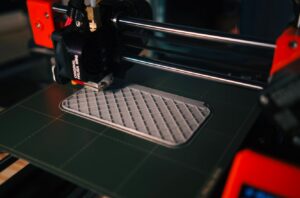The wear resistance and indentation resistance of parts are very important in specific occasions, and a large part of this also depends on the material hardness of the parts. However, after entering the processing stage, if the hardness of the selected material does not necessarily meet the requirements, we often use some surface hardening processes to change the hardness of the finished parts
So what is case hardening? What are the common techniques? What are the advantages of surface hardening besides increased wear resistance? Next, we will take you to understand!
What is case hardening?
Surface hardening is a technique for improving the durability and appearance of a metal surface by adding a thin layer on top of another metal alloy to strengthen the metal surface while keeping the interior of the part relatively soft. Through surface hardening, the wear resistance and fatigue resistance of parts can be significantly improved.
Instead of hardening the entire metal material, only the surface can be hardened, which can improve efficiency. It takes much less time to heat the surface than heating the whole metal, which can save a lot of cost in large-scale manufacturing.
Common Processes for Surface Hardening
Quenching
Quenching is the heating of metal to very high temperatures followed by rapid cooling, usually by immersing the material in oil or water, or exposing it to a stream of cold air.
The rapid cooling “locks in” the microstructural changes that occur when the material is heated, resulting in extremely hard parts.
The quenching process has low cost, simple and flexible process, and has been widely used in the modern machinery manufacturing industry. The important parts in machinery, especially the steel parts used in automobiles, airplanes and rockets, are almost all quenched.
For steel or iron with sufficient carbon content, the quenching effect is obvious. If the carbon content is low, other steps such as nitriding and carburizing can be carried out.
Nitriding
Nitriding treatment refers to a chemical heat treatment process in which nitrogen atoms penetrate into the metal surface at a certain temperature and medium. Nitriding is usually carried out in a nitriding furnace to form a layer of nitride with high hardness and corrosion resistance on the surface.
Generally, there are gas nitriding, liquid nitriding and ion nitriding.
The biggest feature of the nitriding process is that the heat treatment deformation is small and the hardened layer is shallow, which is suitable for parts that work under cyclic loads, such as shafts. Compared with quenching, the chance of deformation is reduced.
carburization
The steel parts with low carbon content are heated in carburizing medium, so that carbon atoms penetrate into the surface, and after quenching, the carbon content of the surface layer increases, and the hardness also increases.
Depending on the application requirements, the external carbon source can be a gas, liquid or solid.
Carburizing is mainly used for parts subject to wear, bending stress and impact load, such as shafts, gears, camshafts, etc. These parts require high hardness on the surface, and sufficient strength and toughness in the core.
Similar to nitriding, the heating temperature is usually lower, reducing the probability of deformation.
After surface hardening, the metal produces a wear-resistant surface, which greatly improves the wear resistance and fatigue resistance of the parts. At the same time, the soft core is retained, so that it has good toughness and strength, and has good resistance to impact loads.
Benefits of Hardfacing
Surface hardening can effectively improve the durability and economy of parts. One of the main advantages of hardened watch cases is that it increases the durability of parts. The mechanical strength and surface hardness and retention of the soft core caused by surface hardening significantly improve the wear resistance and fatigue life of the part. Retaining a soft core improves the ability to absorb energy released by impact loads. It helps to prolong the service life and economic benefits.
Hope the above content can help you!




